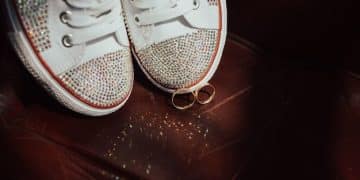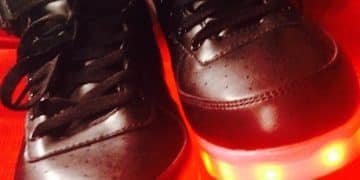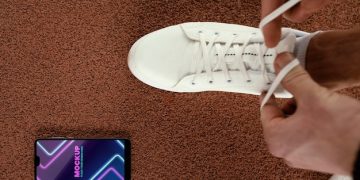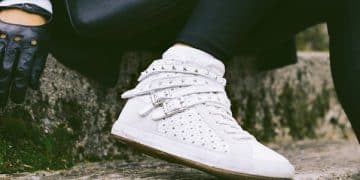Spot Fake Limited-Edition Sneakers in 2025: 7-Point Checklist
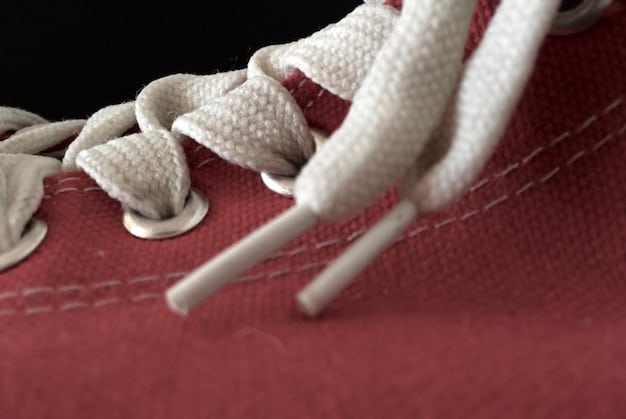
Navigating the exclusive world of limited-edition sneakers in 2025 demands vigilance and expertise to distinguish authentic pairs from sophisticated counterfeits, ensuring your investment and collection remain genuine.
The allure of limited-edition sneakers is undeniable, turning footwear into a coveted asset. However, this demand has fueled a thriving market for counterfeits, making the pursuit of genuine pairs a challenging endeavor. In 2025, with advancements in replication techniques, understanding How to Spot Fake Limited-Edition Sneakers in 2025: A 7-Point Authentication Checklist is more critical than ever for both seasoned collectors and newcomers.
The Evolving Landscape of Sneaker Counterfeits
The counterfeit sneaker market has evolved dramatically, moving beyond crude replicas to highly sophisticated fakes, often termed “super fakes.” These copies are designed to mimic genuine products so closely that even experienced collectors can be fooled. The sheer volume and quality of these replicas make authentication a constant battle, requiring up-to-date knowledge and a keen eye for detail.
Understanding this evolving landscape means recognizing that fakes are not just cheap knock-offs from a back alley anymore. Many are produced in factories with sophisticated machinery, using materials that closely resemble the originals. This shift necessitates a refined approach to authentication, moving beyond superficial checks to a deeper structural and material analysis.
The Rise of “Super Fakes”
Super fakes are a significant challenge because they meticulously replicate almost every aspect of an authentic sneaker. From the box and labels to the tiny details on the stitching and soles, these fakes aim for perfection. The manufacturers of these fakes often get their hands on genuine pairs to reverse-engineer them, learning the exact specifications and even the suppliers of some materials. This makes it incredibly difficult to tell them apart from the real deal without expert knowledge.
- Advanced manufacturing techniques
- Near-identical material sourcing
- Replication of intricate details
- Packaging designed to deceive
This level of sophistication means that casual buyers are at a higher risk of being scammed. Even trusted online marketplaces and resellers occasionally struggle to identify these high-quality counterfeits without rigorous inspection protocols. It emphasizes the importance of an informed buyer, equipped with the right tools and knowledge.
The continuous innovation in counterfeit production means authentication methods must also evolve. What worked last year might not be sufficient today. Buyers need to stay informed about the latest authentication techniques and common flaws found in current fake batches. This proactive approach helps protect investments in a market where authenticity directly correlates with value.
Point 1: Scrutinizing the Packaging, Box, and Labels
The first line of defense often starts before you even touch the sneakers themselves: the packaging. Authentic limited-edition sneakers come in meticulously designed boxes, often with special graphics, labels, and protective elements that counterfeits frequently overlook or get wrong. Even subtle discrepancies here can be glaring red flags upon closer inspection.
Counterfeiters often cut corners on packaging to save on costs and effort. This can manifest in flimsy box construction, faded or pixelated printing, or incorrect typography on the labels. These seemingly minor details are usually perfected by legitimate manufacturers and serve as significant tells for authenticity.
Check for High-Quality Box Construction
A genuine sneaker box should feel sturdy and well-constructed, made from high-quality cardboard. The corners should be crisp, and the folds precise. Fake boxes often use thinner, more cheaply produced cardboard that might feel flimsy or show signs of easy wear and tear. Pay attention to the texture and integrity of the box material itself.
- Sturdy cardboard material
- Sharp, well-defined corners
- No signs of excessive wear or damage on arrival
- Consistent color and finish throughout
Beyond the physical feel, examine the printing on the box. Legitimate brands invest heavily in high-quality printing, resulting in sharp images, clear text, and vibrant colors. Counterfeits might have blurry logos, inconsistent color saturation, or misaligned graphics. Look for any pixelation or smudging in the printed elements, which are strong indicators of a fake.
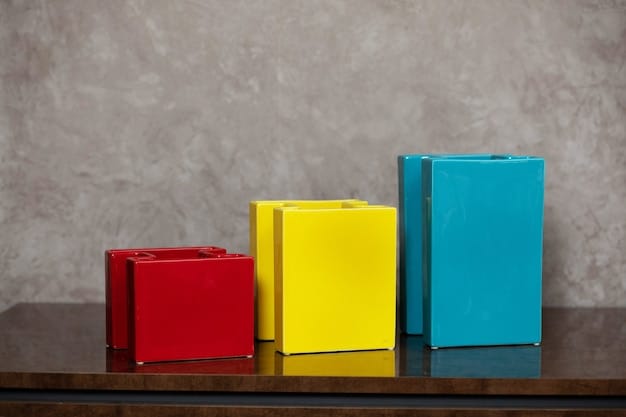
The accuracy of labels is equally crucial. The SKU number on the box should match the SKU number on the shoe’s internal tag. Any mismatch is an immediate sign of concern. Furthermore, check the font, size, and spacing of the text on all labels. Counterfeiters frequently make errors in typography, using slightly different fonts or incorrect spacing, which can be spotted with a keen eye.
Serial numbers, manufacturing dates, and bar codes should also be consistent. Some fake boxes might entirely omit crucial information or present generic, repeated codes. Scanning the barcode with a dedicated app, if available, can sometimes confirm authenticity, though super fakes might also have scannable, albeit fraudulent, barcodes.
Point 2: Assessing Stitching and Material Quality
The meticulousness of stitching and the inherent quality of materials are hallmarks of authentic limited-edition sneakers. Brands invest significantly in premium materials and precision manufacturing, which counterfeits often struggle to replicate perfectly. These elements are harder to fake convincingly than superficial branding.
Genuine materials have a distinct feel, scent, and appearance. Leather should feel supple, suede should have a consistent nap, and mesh should be durable yet breathable. Counterfeiters often use cheaper alternatives that might look similar from afar but fail on closer inspection in terms of texture, durability, and overall quality. This is where tactile inspection becomes as important as visual assessment.
Examine Stitching Precision
High-quality sneakers exhibit clean, even, and precise stitching. There should be no loose threads, frayed edges, or inconsistent stitch patterns. Every seam should be uniform, spaced correctly, and firmly secured. Counterfeit shoes often reveal themselves through sloppy stitching, with uneven lines, inconsistent thread tension, or even missing stitches in critical areas.
- Even and consistent stitch lines
- No loose or frayed threads
- Correct thread color and thickness
- Symmetry in stitching across pairs
Pay close attention to tight corners, logos, and areas where different materials meet. These are common spots where counterfeiters struggle to maintain precision. For example, logos embroidered onto uppers should be sharp, dense, and perfectly formed. If the embroidery looks thin, messy, or disproportionate, it’s a significant warning sign.
The choice and quality of materials are also critical. Real leather has a specific grain and smell that synthetic alternatives can’t fully replicate. Suede on genuine pairs will be soft to the touch and change color slightly when brushed, unlike cheaper, synthetic imitations. Rubber on soles should be durable and have a specific texture for grip, not feel plasticky or too soft.
Point 3: Investigating Logos and Brand Emblems
Logos and brand emblems are core identifiers for any sneaker. Counterfeiters frequently get these details wrong, as even slight variations in font, spacing, size, or placement can be telling. Brands protect their intellectual property fiercely, ensuring their logos are consistently and perfectly reproduced on every authentic pair.
This point requires familiarity with the brand’s specific branding guidelines for the particular model. A quick online search for high-resolution images of authentic pairs can be a valuable reference. Compare the logo on your potential purchase against these genuine images, looking for even the most minute differences.
Check Logo Placement and Consistency
The placement of logos, whether on the tongue, heel, side panels, or insole, should be exact. Counterfeiters often misplace logos, making them too high, too low, or off-center. They might also use incorrect proportions, making a logo appear stretched or compressed. Symmetry between the left and right shoe’s logos is also crucial.
- Accurate logo placement (height, angle, centering)
- Consistent size and proportionality
- Sharp, clean edges on all logo elements
- Absence of smudging or distortions
Beyond placement, examine the quality of the logo itself. For printed logos, ensure the print is sharp, opaque, and does not chip or rub off easily. Embossed or debossed logos should have clean, defined edges and consistent depth. Any signs of blurriness, unevenness, or poor definition are immediate red flags.
The specific font used for branding text is also a common pitfall for fakers. Compare the font on all tags, insoles, and packaging to authentic examples. Slight variations in letter shapes, spacing (kerning), or thickness can reveal a counterfeit. Even the shade of color used for a logo can sometimes be a subtle indicator.
Point 4: Analyzing Soles, Treads, and Midsoles
The sole unit of a sneaker, encompassing the outsole, midsole, and oftentimes air units or cushioning technologies, is a complex part that counterfeiters often struggle to replicate with precision. This is largely due to the proprietary technologies and specialized manufacturing processes involved in creating comfortable and performance-oriented footwear.
Authentic soles are engineered for specific performance characteristics – traction, cushioning, flexibility. The materials used are durable and the design is intricate. Counterfeit soles, while resembling the original visually, often use inferior rubber or foam, leading to noticeable differences in feel, weight, and performance.
Examine the Outsole Tread Pattern
The tread pattern on the outsole of a genuine limited-edition sneaker is a meticulously designed element, often featuring specific patterns or branding that contribute to grip and durability. Counterfeiters might use molds that are slightly off, resulting in less defined patterns, shallower grooves, or even missing details. Compare the tread pattern thoroughly with official product images.
- Sharp and defined tread patterns
- Consistent depth of grooves
- Correct branding or embedded logos within the tread
- Durable, non-slippery rubber material
The feel and flexibility of the outsole material are also critical. Authentic outsoles usually have a specific firmness and grip. Fakes might feel too soft, too hard, or have an unusual plasticky texture. Also, look for any excess glue around the sole’s edges where it attaches to the upper, a common sign of rushed, poor-quality manufacturing.
Midsoles, particularly those incorporating advanced cushioning technologies like Nike’s Air units or Adidas’s Boost, are exceptionally difficult to perfectly replicate. Genuine Air units should be firm yet responsive, and Boost pellets should have their characteristic texture and bounce. Counterfeit midsoles might feel spongy, too hard, or lack the true performance characteristics of the authentic technology.
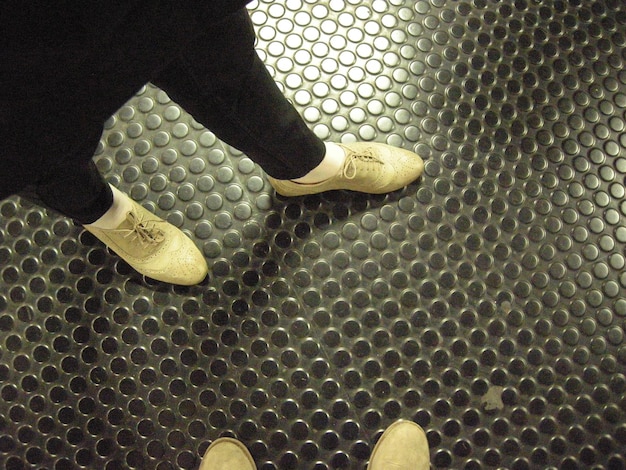
Pay attention to the texture and color of the midsole material. Authentic midsoles will have a uniform color and texture, without streaking or inconsistencies. Any visible glue lines or unevenness in the midsole’s connection to the upper or outsole should raise suspicions. The overall shape and profile of the sole unit should also perfectly match official product photos; subtle differences in curvature or thickness are common tells for fakes.
Point 5: The Smell and Feel Test
While often overlooked, the olfactory and tactile sensations of a sneaker can provide crucial clues to its authenticity. Genuine brands use specific, quality materials and adhere to strict manufacturing standards, which contribute to a particular “new shoe” smell and feel. Counterfeits, on the other hand, frequently betray themselves through distinct odors and inferior textures.
This point requires a keen sense of smell and touch, often contrasting against the experience of handling genuine sneakers. Without prior exposure to authentic pairs, this step might be less definitive, but for experienced collectors, it can be a powerful indicator.
Detecting Chemical Odors
A strong, chemical, or “gluey” smell emanates from many fake sneakers. This is often due to the use of cheap adhesives and synthetic materials not used in authentic production. Genuine limited-edition sneakers might have a subtle smell associated with the materials (leather, rubber) and the fresh factory production, but it’s rarely overpowering or harsh.
- Strong, unpleasant chemical smell
- Overwhelming glue odor
- Absence of the typical “new sneaker” scent (if applicable)
- Unusual or ‘off’ material smells
If you unbox a sneaker and are hit with an immediate, strong, and unpleasant chemical odor, it’s a significant red flag. Authentic shoes, even new ones, generally do not possess such a pungent aroma. This chemical scent often signifies low-quality glues and cheaper, less regulated manufacturing processes.
The “feel” test extends to every component of the shoe. Quality materials, such as premium leather or durable mesh, should feel substantial and well-crafted. Examine the smoothness of the lining, the softness of the collar padding, and the suppleness of any leather or suede sections. Fakes often use stiff, plasticky, or overly soft materials that don’t match the feel of authentic sneakers.
Pay attention to the laces as well. Genuine laces are usually made from high-quality cotton or synthetic blends, feeling soft yet durable, and with a specific texture. Fake laces can often feel cheap, thin, or have an unnatural sheen. Even the weight of the shoe can be a subtle indicator; fakes sometimes feel either too light or disproportionately heavy compared to authentic pairs of the same model.
Point 6: Authentication Tags, Accessories, and QR Codes
Apart from the sneaker itself, what comes with it can also be a crucial part of the authentication process. Limited-edition sneakers often include special hang tags, extra laces, dust bags, and sometimes even authenticity cards. These accessories, and how they interact with modern authentication technologies like QR codes, are increasingly important.
Counterfeiters often try to replicate these accessories but rarely achieve the same level of quality or detail. Even if they include tags, the material, print, or branding on them might be slightly off. This is where attention to every small detail makes a difference.
Verify Hang Tags and Authenticity Cards
High-end limited-edition sneakers frequently come with branded hang tags or specialized authenticity cards. These items should be well-printed, made from quality materials, and consistent with the brand’s aesthetic. Check the font, colors, and any embossed details on these accessories. Fakes often have poorly printed or flimsy tags.
- High-quality printing and material for tags/cards
- Correct branding and logos on accessories
- Serialization or specific codes that match the shoe (if applicable)
- Absence of cheap plastic or paper materials
Many modern sneakers and their accompanying verification systems also incorporate QR codes or NFC chips. If a QR code is present, it should link to the official product page or a brand-specific authentication portal. A fake QR code might lead to a generic website, an inactive link, or simply not work.
The presence and quality of additional laces or dust bags are also worth noting. Genuine extra laces will match the quality and texture of the installed ones, often coming in branded packaging. Dust bags should be made of soft, high-quality fabric with clear, well-printed logos, not flimsy or cheap material.
Small details like the hardware on hang tags (if metal), the quality of plastic inserts for maintaining shoe shape, and even the tissue paper used to wrap the shoes inside the box can provide clues. Brands are meticulous about every aspect of their product presentation, and any deviation can indicate a counterfeit.
Point 7: Deal with Reputable Sellers and Third-Party Authentications
Ultimately, the most effective way to avoid fake limited-edition sneakers is to mitigate the risk at the point of purchase. Dealing with reputable sellers and utilizing trusted third-party authentication services adds a significant layer of security, especially given the rising sophistication of counterfeits.
While the previous six points focus on internal authentication, this final point emphasizes external verification. It’s about due diligence in sourcing and ensuring that experts, where possible, also scrutinize your potential purchase.
Purchase from Authorized Retailers or Reputable Resellers
Always prioritize purchasing limited-edition sneakers from authorized retailers or well-known, established resellers with transparent authentication processes. Authorized retailers receive directly from the brand, guaranteeing authenticity. Reputable resellers have rigorous checks in place to ensure everything they sell is genuine.
- Buy exclusively from official brand stores or websites
- Use trusted sneaker marketplaces with buyer protection
- Verify the reseller’s reputation and customer reviews
- Avoid deals that seem “too good to be true”
Be wary of private sellers on social media or obscure websites offering unbeatable prices. While some private sales might be legitimate, the risk of encountering a fake is significantly higher. If you do purchase from an individual, insist on meeting in person, asking for proof of purchase, and performing your own authentication checks.
For high-value or particularly rare sneakers, investing in a third-party authentication service is highly recommended. Companies like StockX or GOAT have built their business on authenticating sneakers, employing teams of experts. Even if you purchase elsewhere, some services offer authentication as a standalone service, providing peace of mind after a transaction.
These services use their extensive databases, proprietary knowledge of manufacturing flaws (and common counterfeit tells), and trained eyes to identify fakes. Some even use advanced technologies like AI to aid in the authentication process, comparing footwear against millions of data points of both real and fake shoes. This final layer of professional scrutiny is invaluable in 2025’s complex sneaker market.
| Key Point | Brief Description |
|---|---|
| 📦 Packaging Quality | Inspect box sturdiness, print clarity, and label accuracy (SKU match, font). |
| 🧵 Stitching & Materials | Look for even, precise stitching; assess material texture, smell, and durability. |
| ✔️ Logos & Emblems | Verify correct placement, size, font, and clarity of all brand logos. |
| ✅ Seller Reputation | Purchase from authorized retailers or use reputable third-party authenticators. |
Frequently Asked Questions About Sneaker Authentication
Yes, “super fakes” are incredibly challenging to identify. They replicate genuine sneakers with high precision, often using similar materials and manufacturing techniques. Distinguishing them requires expert knowledge, meticulous attention to detail on all sneaker components, and sometimes even professional third-party authentication services, as subtle inconsistencies are often the only giveaways.
While QR codes and NFC chips can be helpful, they are not foolproof. Counterfeiters can sometimes replicate scannable codes that link to fake sites or generic pages. Always ensure the code links directly to the official brand’s website or a verified authentication portal. It’s best to use these digital tools in conjunction with physical inspection for a comprehensive check.
The most common mistake is relying on a single, superficial detail to determine authenticity. The sophisticated nature of fakes means that one correct detail doesn’t guarantee a genuine product. Buyers often fail to examine all aspects comprehensively, from packaging and labels to stitching, materials, soles, and accessories. A holistic approach is essential.
The “smell test” can be a surprisingly effective indicator. Fake sneakers often emit a strong, acrid chemical or glue-like odor due to cheap materials and adhesives. Authentic sneakers, while new, typically have a more subtle, natural scent derived from quality materials. While not definitive on its own, a pungent chemical smell is a strong red flag that should prompt further investigation.
Generally, yes, well-known online reseller platforms like StockX or GOAT are safer choices due to their multi-point authentication processes and buyer protection policies. However, even these platforms aren’t immune to “super fakes” occasionally slipping through. Always review their specific authentication guarantees and understand their refund policies before making a purchase.
Conclusion
The quest for genuine limited-edition sneakers in 2025 demands a blend of keen observation, updated knowledge, and a commitment to meticulous scrutiny. As counterfeiters refine their techniques, relying on a single authentication method is no longer sufficient. By adopting this seven-point checklist, encompassing everything from the initial packaging details to the very last stitch, collectors can significantly enhance their ability to distinguish authentic treasures from sophisticated fakes. Protecting your investment and the integrity of your collection hinges on your vigilance and informed decisions in an ever-evolving market.
